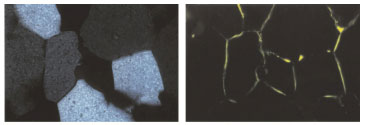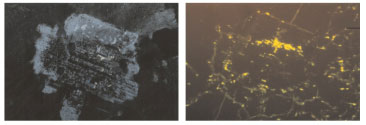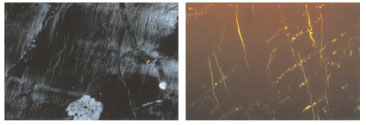Background
The PSG (Pore Space Geometry) experiment involves the injection of a specially formulated acrylic resin into the granitic rocks of the GTS (Grimsel Test Site) to determine a wide range of information on the in-situ porosity. Grimsel granite and granodiorite is composed mainly of crystals of quartz, feldspars and biotite. In previous studies at the GTS (NTB 00-08), a fluorescent resin was injected into the rock matrix. After polymerisation of the resin, the matrix core could be removed for analysis without disturbing the in-situ pore distribution. The resin impregnated sites were visible under ultra-violet light. This study observed four main types of pore within the matrix.
Why is the matrix important ?
Conservative estimates of the long term fate of radioactive wastes assume that some radionuclides will eventually leak from the waste into the host rock surrounding the repository. There are two main processes which lead to the retardation of radionuclides in the host rock, sorption and diffusion. When determining the safety of repositories (the repository safety assessment), the degree of radioactive retardation by diffusion is often underestimated due to uncertainties in the properties of the matrix. These over-conservative estimates of limited matrix diffusion depths may grossly underestimate retardation of radionuclides in the geosphere, especially for non-sorbing radionuclides such as 129I
Furthermore, previous studies at the GTS using resin impregnation have shown that changes to the measured porosity of the rock may occur when un-impregnated samples are removed to the laboratory for analysis. This can result in laboratory measured porosities 2 to 3 times higher being measured in the laboratory than present in situ.
Due to the great potential significance of this work to safety analysis calculations, it was decided to study this further using an alternative resin technique to the previous tests at the GTS. Over the last decade, the 14C-PMMA method has been developed for characterisation of pore space geometry for low permeable rock matrices. Impregnation with 14C-PMMA and autoradiography allows the investigation of the spatial distribution of in-situ porosity.
Full details are avialable on the Grimsel website : http://www.grimsel.com/psg/psg_intro.htm |
 DM
Multimedia Ltd
DM
Multimedia Ltd






